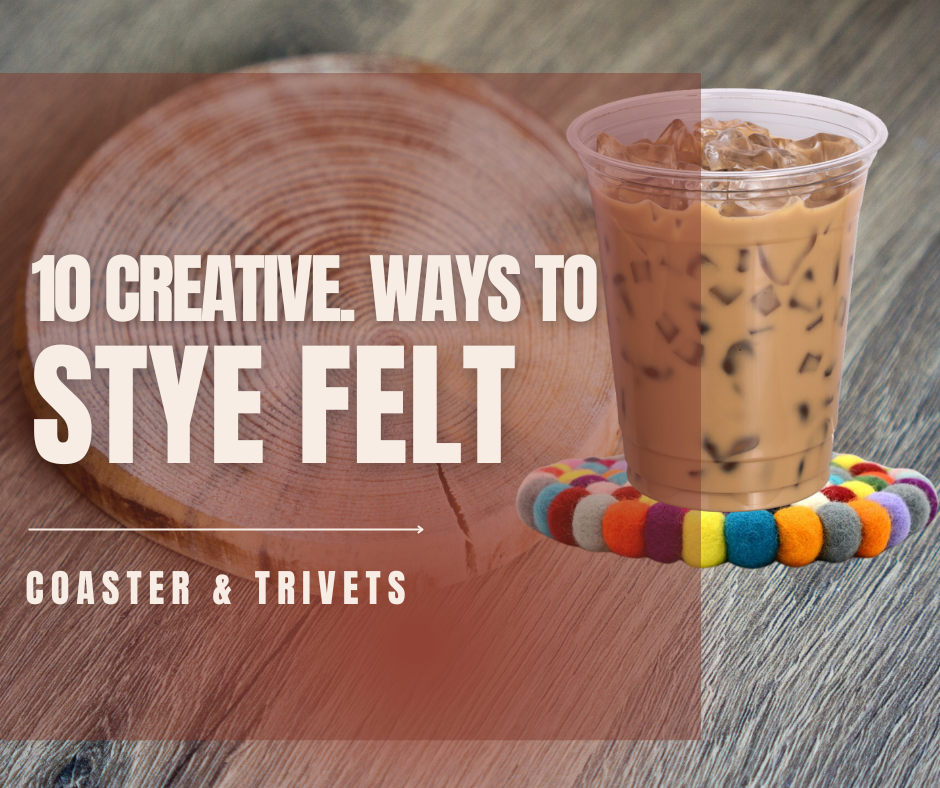The History and Tradition of Felt Making: A Timeless Handmade Craft
Felt making is one of the oldest textile crafts known to humankind, with a legacy that spans over 8,000 years. Its versatility, durability, and eco-friendly nature have made it an essential material in various cultures throughout history. Whether used for clothing, home décor, or spiritual practices, felt has remained a timeless craft that blends artistry with functionality.
In this blog, we will explore the origins of felt making, the cultural significance it holds in different regions, and how the craft continues to thrive in today’s handmade market.
The Ancient Origins of Felt Making
Felt making can be traced back to ancient Mesopotamia, Mongolia, and Central Asia, where evidence suggests that nomadic tribes were among the first to create felt. These early civilizations used felt for practical purposes, including shelters, clothing, and armor. Felt’s insulating properties made it ideal for protection against harsh weather conditions, while its strength and flexibility provided a lightweight material that could withstand wear and tear.
How Was Felt Made in Ancient Times?
The basic process of felt making has remained unchanged for millennia. The traditional method involves layering raw wool fibers, adding water, and using heat and pressure to bind the fibers together. This technique is known as wet felting, and it was a significant innovation in textile production. In ancient times, soap or natural oils were often added to facilitate the felting process. The wool was then rolled, pressed, or stomped on to create a dense, durable fabric.
The Role of Felt in Nomadic Cultures
Nomadic tribes in Central Asia, such as the Mongols and Turkic peoples, heavily relied on felt for their way of life. One of the most famous uses of felt in nomadic culture is the yurt, a portable dwelling that provided both warmth and protection. These large tents were made of felted wool, which acted as a natural insulator, keeping the interior cool in the summer and warm in the winter.
Felt for Clothing and Armor
Beyond its use in shelters, felt was a crucial material for clothing and even armor. Nomads would use felt to create lightweight, durable garments that protected them from the elements. Felted armor, while not as strong as metal, was an effective form of defense and could absorb blows during battle. Felt shoes and hats were also popular and are still worn in some traditional cultures today.
Felt Making in European History
Felt spread across Europe during the Middle Ages, where it played a significant role in the production of clothing, particularly hats. Felt hats became fashionable in Europe during the 16th century, known for their durability and ability to maintain shape. Felt-making guilds were established, and the craft became an essential part of the European textile industry.
The Renaissance of Felt Hats
Felt hats reached their peak popularity in the Renaissance era, when they were worn by everyone from peasants to royalty. The felt hat industry was so crucial that cities like Venice and London became known for their hat-making craftsmen. These hats were often adorned with feathers and jewels, symbolizing wealth and status.
The Cultural Significance of Felt in Asia
In Asia, particularly in Tibet and Mongolia, felt has deep cultural and spiritual significance. Felt-making is not just a craft but an art form that is passed down through generations. In Tibetan culture, felt is used to make rugs, wall hangings, and prayer mats, which play a significant role in religious ceremonies.
Felt in Religious and Ceremonial Practices
In Mongolian shamanism, felt is believed to have protective and healing properties. Shamans use felt in their rituals to ward off evil spirits and to bring harmony to the home. Felt is also used to create decorative pieces for special occasions, such as weddings and festivals, where it represents both wealth and protection.
The Evolution of Felt-Making Techniques
While wet felting has been the traditional method of making felt for centuries, newer techniques such as needle felting have emerged in the modern era. Needle felting, which involves using barbed needles to interlock fibers, has allowed artisans to create more detailed and intricate designs.
Needle Felting: A Modern Twist on an Ancient Craft
Today, needle felting is a popular technique used by artisans to create decorative items, sculptures, and even toys. This modern approach to felting has opened up new creative possibilities, allowing crafters to produce three-dimensional felt products that were previously difficult to achieve with wet felting alone.
Felt in Modern Art and Fashion
In recent years, felt has made a resurgence in the world of art and fashion. Designers are embracing felt for its sustainability, texture, and versatility. Felted garments, accessories, and home décor items are gaining popularity, particularly among eco-conscious consumers who value handmade and sustainable products.
Felt in Contemporary Art Installations
Felt has also become a medium for contemporary art. Artists such as Joseph Beuys have used felt in their installations to explore themes of warmth, protection, and human experience. The texture and malleability of felt allow artists to create unique pieces that provoke thought and emotion.
Felt’s Environmental Benefits
One of the reasons felt has endured as a material for so long is its environmentally friendly properties. Felt is made from wool, a renewable resource, and the process of felting does not require harmful chemicals or synthetic materials. Felt is also biodegradable, making it an ideal choice for those looking to reduce their carbon footprint.
Sustainable and Eco-Friendly Felt Products
The rise in demand for sustainable products has led to a renewed interest in felt. Artisans and consumers alike are drawn to felt for its natural qualities and its ability to last for years without losing its shape or function. Felt is now being used to create eco-friendly home decor, clothing, and accessories that are both beautiful and environmentally responsible.
Handmade Felt: Preserving a Timeless Tradition
Despite advances in technology and synthetic fabrics, handmade felt remains a cherished craft. Artisans around the world continue to practice traditional felting methods, preserving the cultural heritage of this ancient textile. Whether through the creation of felt art, clothing, or home goods, the craft of felt making continues to thrive in today’s handmade markets.
Conclusion: The Enduring Legacy of Felt Making
The history and tradition of felt making are a testament to its timelessness. What began as a practical craft in ancient civilizations has evolved into a global art form that continues to inspire artisans and consumers alike. From its humble beginnings in nomadic cultures to its role in modern art and fashion, felt has proven itself as a versatile, sustainable, and enduring material that stands the test of time.
As we look toward the future, felt making will continue to be celebrated for its rich history, its environmental benefits, and its unique ability to connect us to our past while still remaining relevant today.
FAQs (Frequently Asked Questions)
Felt making originated in ancient civilizations like Mesopotamia and Mongolia, where it was used for clothing and shelter.
Traditional felt is made through wet felting, where wool fibers are matted together using water, heat, and pressure.
Felt was vital for nomads, used in making yurts, clothing, and armor due to its insulating and durable properties.
While wet felting remains popular, modern techniques like needle felting allow for intricate, three-dimensional designs.
Yes, felt is biodegradable and made from renewable wool, making it an eco-friendly material for sustainable products.
Contact us:
- info@himalayanaesthetics.com
- +91 9900618954
- Flat no 208, Rangashree Pearl 5th Main Rd, opposite to KSIT, Raghuvanahalli, Bangalore City Municipal Corporation Layout, Bengaluru, Karnataka 560019
Copyright 2025 © Himalayan Aesthetics. All Rights Reserved.



